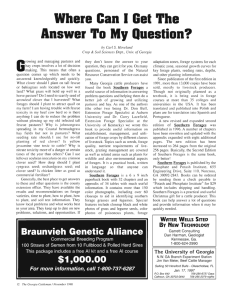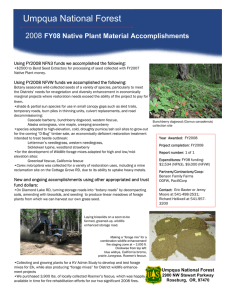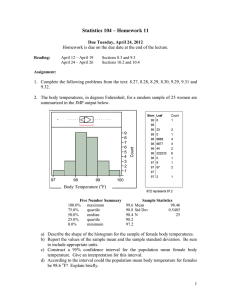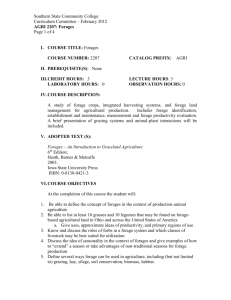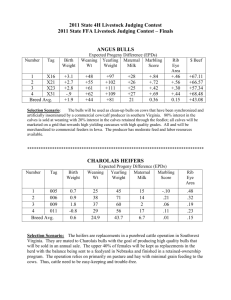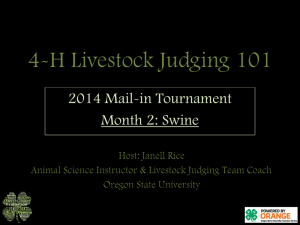Behavior, preference for, and use of alfalfa, tall fescue, white... by pregnant gilts in an outdoor production system
advertisement
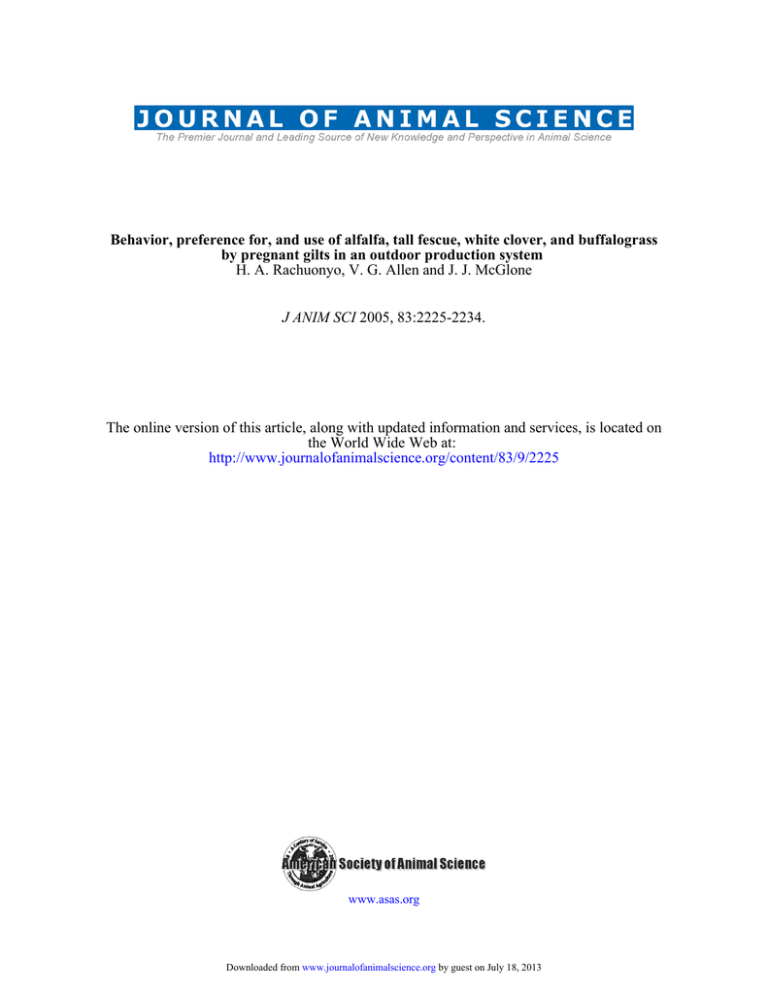
Behavior, preference for, and use of alfalfa, tall fescue, white clover, and buffalograss by pregnant gilts in an outdoor production system H. A. Rachuonyo, V. G. Allen and J. J. McGlone J ANIM SCI 2005, 83:2225-2234. The online version of this article, along with updated information and services, is located on the World Wide Web at: http://www.journalofanimalscience.org/content/83/9/2225 www.asas.org Downloaded from www.journalofanimalscience.org by guest on July 18, 2013 Behavior, preference for, and use of alfalfa, tall fescue, white clover, and buffalograss by pregnant gilts in an outdoor production system1 H. A. Rachuonyo*2, V. G. Allen†, and J. J. McGlone*3 *Pork Industry Institute, Department of Animal and Food Sciences, and †Department of Plant and Soil Science, Texas Tech University, Lubbock 79409 ABSTRACT: Sustainable outdoor pig production requires vegetation that can maintain ground cover, assimilate manure nutrients, and prevent soil erosion. Two experiments were conducted to evaluate the suitability of four forages: alfalfa (Medicago sativa), tall fescue (Festuca arundinacea), white clover (Trifolium repens), and buffalograss (Buchloe dactyloides) for grazing or ground cover in pastures for pigs. Each forage plot covered 7.5 m2, with nine replicates in a randomized block design. In Exp. 1, eight pregnant gilts had free access to all forages during a 2-d adjustment period. Immediately thereafter, pairs of gilts were assigned randomly to one of each of four blocks of the four forages during a 2-d measurement period. The percentage of ground cover for each forage was visually estimated at 0, 24, and 48 h of study. Behavioral data, including walking, eating, grazing, rooting, drinking, standing, lying, and time spent in hut were video-monitored continuously for 48 h. Initial percentage of ground cover was 100% for all species. By 48 h, percentage of ground cover decreased (P < 0.001) for white clover (11.3 ± 0.88%) and alfalfa (36.3 ± 0.88%), but not for tall fescue (98.0 ± 0.88%) or buffalograss (98.0 ± 0.88%). Gilts spent more (P < 0.01) time grazing white clover (16.3 ± 1.97 min/d) and alfalfa (11.2 ± 1.97) than tall fescue (0.8 ± 1.97) or buffalograss (0.3 ± 1.97), and rooted more (P < 0.04) white clover than other forages. In Exp. 2, six gilts from the initial group were put on six blocks of the four forages. Each gilt was assigned randomly to three replicates of each forage, including alfalfa, tall fescue, or buffalograss (white clover was excluded because of damage by gilts during Exp. 1), and gilts grazed single forages for 2 d. After this grazing period, the percentage of ground cover was less (P < 0.01) for alfalfa than for buffalograss or tall fescue (37.5 ± 0.38, 96.7 ± 0.39, 96.3 ± 0.39%, respectively). With access to a single forage, pregnant gilts spent more (P < 0.01) time grazing alfalfa (15.8 ± 2.36 min/d) than buffalograss (1.5 ± 2.36) or tall fescue (0.7 ± 2.37). These gilts clearly preferred grazing white clover and alfalfa, and rooting and eating white clover compared with buffalograss or tall fescue. Rates of ground cover loss were less (P < 0.01) for tall fescue and buffalograss than for the more preferred forages. Less preferred forages could have potential as pasture for swine when the primary objective is ground cover maintenance rather than nutrient supply. Key Words: Behavior, Environment, Forage, Grazing, Ground Cover, Pigs 2005 American Society of Animal Science. All rights reserved. Introduction Finding forages with nutritive value that assimilate manure nutrients and maintain ground cover is a practical challenge facing outdoor pig producers. The value 1 This research was supported by the USDA-Fund for Rural America, Consolidated Nutrition, LLC, and Texas Tech Univ. The authors thank the late J. A. Morrow (ARS, USDA) and S. E. Curtis for manuscript preparation, as well as J. Dailey (ARS, USDA), J. Smith, P. Brown, K. Armes, and G. Collins for technical assistance during the study. 2 Current address: North Carolina State Univ., Animal Science Dept., 202 Polk Hall, Campus Box 7621, Raleigh 27695. 3 Correspondence—e-mail: john.mcglone@ttu.edu. Received August 1, 2004. Accepted June 4, 2005. J. Anim. Sci. 2005. 83:2225–2234 of forages in swine production is well established (Kephart et al., 1990; Wheaton and Rea, 1993). McCarty and Grimes (1930) and Zeller (1948) noted that goodquality forage should be well adapted to soil and climatic conditions, produce large yields of palatable feed over a duration or abundant forage over a short time, endure heavy grazing, and be grown at small expense. Sustainable farming uses natural animal–plant interrelationships to improve ecological, biological, and socioeconomic viability of farmlands (Baker et al., 1990). In regenerative livestock-cropping systems, forages act as sources of nutrients for livestock, help maintain soil fertility and desirable physical properties, decrease erosion, and recycle nutrients (Hollins, 1984; Varel and Yen, 1997). According to the U.S. EPA (2001), animals on “pastures” with denuded ground for more than 45 d within 2225 Downloaded from www.journalofanimalscience.org by guest on July 18, 2013 2226 Rachuonyo et al. a 12-mo period might result in the classification of facility as a confined feeding operation. The USDA/NRCS (2000) may consider pigs on pasture in violation of regulations when the percentage of ground cover falls below 70%. Swine grazing is not widely practiced in the United States; however, gestating swine can use fibrous feed effectively because of the sows’ relatively low energy needs (Pond, 1981). Alternatively, pastured sows can be fed a complete diet to minimize forage consumption, with maintenance of ground cover as a way of decreasing erosion and pollution. Outdoor swine units may alleviate negative perceptions from the public on animal welfare, health of workers, and environmental concerns associated with odor, dust, and nutrient management. Objectives of the present study were to evaluate preferences and grazing behavior by pregnant gilts on selected forage species and to determine loss of ground cover over time as a result of activities of the gilts. Materials and Methods Location and Experimental Conditions Two experiments were conducted at the Sustainable Pork Farm of Texas Tech University, located near Idalou (lat 33°42′N; long 101°36′W; elevation 977.2 m). Climate in the region is semi-arid, with average annual precipitation of 45.7 cm. Soils are primarily Pullman clay loam (fine, mixed, superactive, thermic Torrertic Paleustolls). Between August 10 and 17, 1999 (1 yr before the study), four forage types were established in an area of approximately 271 m2 in a randomized complete block design with nine blocks. Individual plots of forage measured 7.5 m2. Forages were ‘Cody’ alfalfa (Medicago sativa), ‘common’ medium white clover (Trifolium repens), ‘Grande’ tall fescue (Festuca arundinacea), and ‘Texoka’ buffalograss (Buchloe dactyloides). Forages were irrigated with a zinc impulse (model DY602N7, Garden Plus, North Wilkesboro, NC) sprinkler system at full flow three times weekly during dry periods. Forages were mowed on May 11 and July 6, 2000 (model 11A-424C06264163, Yard Machines, Briggs & Stratton, Cleveland, OH), and clippings were removed from plots. Forages were mowed again on August 16, 2000, after the end of the first experiment to improve uniformity in growth before the second experiment. Each forage area (271 m2) was fertilized by hand-broadcasting commercial fertilizers (primarily N and P2O5) on May 15, June 8, and July 6, 2000, to ensure that nutrients did not limit plant growth. The forage perimeter was fenced with wire mesh (0.9 m high) to exclude wild animals. When grazing began, at least 10% of alfalfa plants were in bloom, white clover plants were in full bloom, and the grasses were completely established at 100% ground cover. In Exp. 1, eight pregnant gilts (mean BW = 183.1 kg) that had previously grazed ‘Spar’ old world-bluestem (Bothriochloa ischaemum) were introduced to each of the four forages by allowing free access to four blocks of forages during a 2-d adjustment period. Immediately following this, pregnant gilts (two per block) were assigned randomly on August 9, 2000, to four blocks of previously ungrazed forages. Each block was individually enclosed with fencing panels (0.9 m high) around the perimeter so that, within a block, gilts had free access to all four forages. Gilts were assigned to their respective blocks at approximately 1400 and stayed for 48 h, after which they were returned to their regular gestation pastures with ‘Spar’ old world-bluestem as the dominant forage. A hut (Quonset style; 2.2 m long × 1.4 m wide × 1.2 m high) and water trough (1.8 × 0.6 m; Doerr Manufacturing Co., Lincoln, NE) were placed adjacent to each block in an area not planted with forage to provide shelter and water (Figure 1). In Exp. 2, six gilts from the initial group (mean BW = 209.3 kg) were used. Individual forages in six previously grazed blocks of forages were used. Each gilt was placed at random on an individual forage (one gilt per forage) for the first two blocks on September 11, 2000. White clover was excluded from Exp. 2 because of damage by gilts during Exp. 1. Two groups of three gilts each stayed in their respective pens for 48 h before being reassigned randomly to the next set of three forages, until all six forage-plot sets had been grazed. The first groups went in at approximately 1230 on d 1 and were moved to the second and third sets of forage 2 d later. Huts and water troughs were used as described for Exp. 1. In both experiments, pregnant gilts were fed a pelleted gestation diet designed to meet nutritional requirements of gestating gilts with an expected intake of 2.5 to 3 kg/(giltⴢd) (Rachuonyo, 2001). A measured amount of feed (2.7 kg/gilt, as-fed basis) was placed on the ground each morning between 0830 and 1100. Water was available ad libitum. In both experiments, Camborough-22 gilts (PIC USA, Inc., Franklin, KY) in early gestation (4 to 7 wk after mating) were used. The Texas Tech University Animal Care and Use Committee approved the protocol for these experiments. Data Collection Because the plots were small, the trials were limited to 2 d to minimize damage to the forages, especially white clover and alfalfa. A weather station (model 7440, Weather Monitor II, Davis Instruments, Baltimore, MD) was located within the study area. Temperature, rainfall, humidity, wind speed, and wind direction data were collected and archived every 15 min. For both experiments, percentage of ground cover for each forage was estimated visually at 0, 24, and 48 h of the grazing period according to techniques published previously (Abaye et al., 1997; Rachuonyo et al., 2002). During Exp. 1, four steel posts (2.4 m high, augmented with a 0.9-m-high wooden post) were used to suspend cameras (model No. WV-BP332, Panasonic CCTV, Mit- Downloaded from www.journalofanimalscience.org by guest on July 18, 2013 Forages for outdoor gilts 2227 Figure 1. Plan of the experimental site and location of forages, camera, hut, water trough, and feeding area used in two experiments to evaluate behavior of pregnant gilts and preference for and use of forage species at the Sustainable Pork Farm of Texas Tech University near Idalou, TX (not drawn to scale). In Exp. 1, pairs of pregnant gilts were confined to four blocks of alfalfa, buffalograss, tall fescue, and white clover forages for 48 h. In Exp. 2, six pregnant gilts from Exp. 1 were confined individually to a single stand of alfalfa, buffalograss, or tall fescue for the same trial duration. sushita, Philippines) 3 m above ground. Cameras were located on the middle section of the outside perimeter of the forage under study (Figure 1). Two cameras with a similar set-up were used during Exp. 2 for each of the two groups of three gilts. Behavior was video-recorded using a Panasonic VCR (model No. AG-TL500P), filming at 0.8 frames/s. Lighting was provided overnight by low-luminous-intensity (35 W) halogen bulbs. Periods when gilts moved beyond the view of the camera but were outside their huts were registered as “Dark.” Behavior activities including walking, eating, grazing, rooting, drinking, standing, lying, wallowing, and time spent in hut were continuously monitored via cameras using procedures defined by Dailey and McGlone Downloaded from www.journalofanimalscience.org by guest on July 18, 2013 2228 Rachuonyo et al. Table 1. Visual estimation of the percentage of ground cover at times 0, 24, and 48 h during grazing of alfalfa, buffalograss, tall fescue, and white clover or alfalfa, buffalograss, and tall fescue forages by pregnant gilts with free access to all (Exp. 1) or confined to individual forage species (Exp. 2) Time of ground cover estimation, h forage 0 24 48 SEa P-value % Exp. 1 Alfalfa Buffalograss Tall fescue White clover Exp. 2 Alfalfa Buffalograss Tall fescue 100.0 100.0 100.0 100.0 51.3bc 98.0 98.0 35.0b 36.3bc 98.0 98.0 11.3b 0.88 0.88 0.88 0.88 0.001 0.12 0.12 0.001 100.0 100.0 100.0 50.0d 98.4 98.3 37.5d 96.7 96.3 0.38 0.39 0.39 0.001 0.052 0.052 a n = 8 and 12 per mean for Exp. 1 and Exp. 2 respectively. The mean of alfalfa and white clover differed from the mean of buffalograss and tall fescue, P < 0.001. c The mean of alfalfa differed from white clover, P < 0.001. d The mean of alfalfa differed from the mean of buffalograss and tall fescue, P < 0.001. b (1997b). All tapes were later time-coded and registered using a Panasonic VCR (model No. AG-6740P, Matsushita, Japan) to enable quantification of behavior over time. Data were acquired by viewing tapes and registering behavior patterns at 0.13 frames/s using Observer software (Noldus Information Technology, Wageningen, The Netherlands). Statistical Analyses Experiment 1 was a randomized complete block design, with four forage species per block. Effects of time (0, 24, and 48 h) were analyzed as repeated measures. Experiment 2 was a completely randomized design, with gilts exposed to a single, randomly selected forage species as the experimental unit. Data were analyzed for time spent within each forage or other location for the various behavior patterns. All data were analyzed using SAS GLM procedures (SAS Inst., Inc., Cary, NC). When a significant treatment effect was detected at P ≤ 0.05, means were separated by the PDIFF option within GLM. Legumes vs. grasses, alfalfa vs. white clover, and tall fescue vs. buffalograss in Exp. 1, as well as alfalfa vs. grasses and tall fescue vs. buffalograss in Exp. 2, were compared using SAS orthogonal contrast procedures. Results During both experiments, climatic conditions were typical for the region of West Texas. Mean daily low temperature was 17.5°C (SD = 7.3) and occurred at approximately 0700, and maximum temperature was 39.3°C (SD = 7.3) and occurred at approximately 1600. Mean daily relative humidity at 0700 was 61.5% (SD = 15.8), and it was 23.2% (SD = 15.8) at 1600 (Rachuonyo, 2001). Experiment 1 At the beginning of the grazing period, no differences in percentage of ground cover were present and all forages were at 100% ground cover (Table 1). Percentage of ground cover decreased rapidly for white clover and alfalfa, but grazing had little effect on the grasses. By 24 h, the percentage of ground cover was lower (P < 0.001) in legumes than in grasses, and this difference became greater by 48 h. Furthermore, percentage of ground cover was less (P < 0.001) in white clover than in alfalfa at both the 24- and the 48-h time periods, whereas no differences were observed between tall fescue and buffalograss at any time. White clover was grazed completely to ground level in all plots by 48 h. Gilts even progressed to taking out roots of white clover plants after consuming the canopy. Gilts stripped tender leaves from alfalfa plants, leaving only the fibrous portions of stem. Behavioral results indicated that gilts walked on and grazed alfalfa and white clover more (P < 0.03 and 0.05, respectively) than buffalograss (Table 2). Gilts also rooted white clover more (P < 0.04) than other forages. Gilts spent more (P < 0.05) time standing on alfalfa than on buffalograss or white clover, but lay on tall fescue for a relatively longer duration than other forages, although this difference was not significant. As was expected due to the physical arrangement of the experimental area, eating, drinking, wallowing, and time spent inside the hut were higher (P < 0.05) for the region off than on the forages. More (P < 0.03) walking also occurred off forages. Comparison of behavioral data across days indicated that time spent eating, drinking, and inside hut was greater (P < 0.05) on d 1 than on d 2, whereas walking time was greater (P < 0.06) on d 2 (Table 3). Values for other behavioral traits did not differ between days. Downloaded from www.journalofanimalscience.org by guest on July 18, 2013 2229 Forages for outdoor gilts Table 2. Duration of behavior of pregnant gilts with free access to alfalfa, white clover, tall fescue, or buffalograss forages in Exp. 1 (each forage was in monoculture on 7.5 m2 plot) Duration of behavior, min/24 ha Forage Alfalfa Buffalograss Tall fescue White clover Other areaf SEg Walking Grazing Rooting Standing Lying Feeding Drinking Wallowing In-hut Darkb 18.7d 8.0e 13.3de 17.3d 25.1c 1.85 67.1d 1.6e 5.0e 104.0c 3.0e 11.82 1.0d 0.1d 0.2d 12.7c 0.9d 3.68 23.3c 7.0d 17.4cd 11.7d 26.8c 3.88 33.8 2.0 123.8 7.3 103.0 47.12 0.0d 0.0d 0.0d 0.0d 37.7c 0.59 0.0d 0.0d 0.0d 0.0d 1.0c 0.25 0.0d 0.0d 0.0d 0.0d 73.5c 6.84 0.0d 0.0d 0.0d 0.0d 592.5c 46.65 0.7 0.0 0.8 0.3 32.6 14.62 a Described by Dailey and McGlone (1997b). Refers to when gilts were outside view of camera. c,d,e Means within a column with different superscripts differ, P < 0.05. f Refers to the area where the hut and water trough were placed in the pen and feeding took place. g n = 4 per mean. b When behavioral activities of gilts were examined at 4-h intervals over 24 h, gilts walked more (P < 0.02) between 0430 and 0830 than during other periods (Table 4). Sunrise occurred at approximately 0700 and sunset at approximately 2035 on August 9 to 11, 2000. A second but lesser peak (P < 0.05) of walking activity occurred between 1230 and 1630. Walking was least (P < 0.02) between 1630 and 0430 and after the morning feeding, corresponding with peak times when gilts were lying. Duration of grazing was greater (P < 0.03) early in the morning and in the afternoon, and gilts rooted more (P < 0.01) in the morning (Table 4). Drinking mostly came after feeding time. Time spent standing was longer (P < 0.03) when gilts were waiting to be fed in the morning; however, lying occurred more (P < 0.03) after sunset. High summer temperatures probably influenced gilts to use the water trough more (P < 0.003) between 1230 and 1630 as a wallow to cool their bodies. This also was the period when gilts used huts more (P < 0.03) than other times. Huts also were used more (P < 0.03) between 2030 and 0030, as well as between 0830 and 1230. These periods corresponded to darkness and time of highest temperature, respectively. Table 3. Two-day comparison of behavior by pregnant gilts with free access to alfalfa, white clover, tall fescue, or buffalograss paddocks for grazing in Exp. 1 Duration of behavior, min/24 h Behavior Day 1 Day 2 SEa P-value Walking Grazing Rooting Standing Lying Feeding Drinking Wallowing In-hut Darkb 14.3 39.9 0.5 13.5 36.7 8.9 0.32 15.9 146.7 13.4 18.7 32.5 5.4 21.0 71.3 6.1 0.11 13.5 90.3 0.4 1.51 5.19 2.20 2.76 19.09 0.49 0.05 0.11 17.39 9.22 0.06 0.33 0.14 0.07 0.22 0.001 0.02 0.14 0.04 0.34 a n = 4 per forage. Refers to when gilts were outside the view of camera. b Experiment 2 During Exp. 2, when gilts were exposed to a single forage species, alfalfa was grazed more (P < 0.01) than either of the two grasses (Table 1). Percentage of ground cover for alfalfa was less (P < 0.001) than the mean of the grasses at both 24 and 48 h, although no differences existed among these species at the time grazing began. As was observed in Exp. 1, grazing had little effect on percentage of ground cover of either buffalograss or tall fescue during the 48-h grazing period. Behavioral measurements also indicated that gilts spent more (P < 0.002) time grazing alfalfa than the grasses, although they stood more (P < 0.02) on buffalograss (Table 5). Other behavioral measures did not differ among the three forages. A 2-d comparison of gilt behavior during Exp. 2 indicated that eating took more (P < 0.04) time on d 1, whereas rooting activity was greater (P < 0.03) on d 2 (Table 6). Behavioral activities over 24 h in Exp. 2 are presented in Table 7. Gilts walked more (P < 0.04) between 1000 and 1800 than at other times. Eating peaked between 1000 and 1400 because gilts were fed later in the day in Exp. 2 than in Exp. 1 (approximately 1030 and 1100, respectively). Grazing was minimal during feeding time and between 2200 and 0200 because gilts were resting. The high grazing peak was observed between 0200 and 0600. Sunrise occurred at approximately 0730 and sunset at approximately 2055 on September 11 to 17, 2000. Rooting behavior also was greater (P < 0.01) in the morning (0600 and 1200). Gilts seemed to resort to rooting behavior as they waited for their daily ration, and as in Exp. 1, drinking peaked after eating. Standing behavior was manifested more (P < 0.03) between 1000 and 1400 and between 0600 and 1000 than at other times. Gilts lay outside the hut more (P < 0.05) during the afternoon (1400 and 2200), which also was the period when gilts wallowed in the water trough and used hut-shade more (P < 0.03) to decrease temperature. Discussion Various outdoor swine production systems have been described in the literature (Thornton, 1988; Klober, Downloaded from www.journalofanimalscience.org by guest on July 18, 2013 2230 Rachuonyo et al. Table 4. Influence of time of day on behavior of pregnant gilts having free access to alfalfa, white clover, tall fescue, or buffalograss for a total of 48 h in Exp. 1 Start of 4-h time periods Behavior 0030 0430 0830 2.5d 11.4b 0.76bc 0.48cd 13.8bc 0.0e 0.000c 0.0d 16.5bc 3.1 6.1b 8.0bc 1.96b 12.09b 6.2cd 3.9b 0.120b 0.3d 8.7c 0.8 1.42de 1.2d 0.04c 2.34c 1.0d 3.0c 0.027c 3.7c 20.2bc 0.0 1230 1630 2030 SEa P-value 1.9d 9.6b 0.10c 0.60cd 10.8bcd 0.0e 0.009c 2.0cd 23.3b 0.0 0.5e 0.8d 0.64c 0.15d 20.5b 0.0e 0.006c 0.0d 23.3b 3.09 0.34 1.23 0.53 0.07 3.94 0.13 0.03 0.82 4.76 1.49 0.02 0.03 0.01 0.03 0.03 0.003 0.03 0.003 0.03 0.14 min/4-h period Walking Grazing Rooting Standing Lying Feeding Drinking Wallowing In-hut Darkf 4.0c 5.1c 0.03c 0.58cd 1.6d 0.6d 0.056bc 8.7b 26.7b 0.0 a n = 4 paddock blocks per mean. Means within each behavior category with different superscripts differ at the P-value indicated. f Refers to when gilts were outside the view of camera. b,c,d,e 1993; Honeyman, 1996). A number of advantages of grazing forages by swine have been noted, such as lowering feed costs, allowing pigs to exercise with the potential of better meat quality, provision of extra nutrients to the animals, lower initial capital investment, better use of land less suitable for cropping, decreased agonistic behavior, improved animal welfare, and favorable environmental perception (Thornton, 1988; Honeyman, 1996; McGlone, 1999). In some recent studies, greater growth performance and better meat quality effects have been reported from pigs raised outdoors (Enfält et al., 1997; Gentry et al., 2002a,b; Olsson et al., 2003). Constraints to swine production on pasture include weather variability, land availability, soil damage, pollution potential, and the labor and logistics of supplying feed and water in all weather conditions (Edwards, 1999). Pigs on pasture may have higher energy needs than those raised indoors due to exercise and thermal extremes. Quality and quantity of forages available for grazing vary during the grazing season, requiring adjustments in stocking rates, supplementation, and total amount of pasture area. Several studies have been published on use of forage as a source of nutrients for swine (Pond et al., 1985; Calvert, 1991; Varel and Yen, 1997); however, to our knowledge, no studies have been made to evaluate preferences of swine for particular forage types and how different forages respond to swine occupation. Raising swine on outdoor pastures or dirt pens accounts for less than 2% of pigs finished in the United States today, with an additional 9% kept in open buildings with outdoors access (NAHMS, 2001). Nearly a century ago, scientists suggested improving foraging use could lead to less grain use, which would decrease feed resource needs, expense, and storage, hence decreasing production costs (Quinn, 1908; Snapp, 1915; Yoke, 1918). Highly palatable forages with high intake potentials could decrease the proportion of concentrates in the diet, thereby minimizing imports of feed and resulting in lower nutrient (manure) load on the environment (Cherney and Allen, 1995). Wheaton and Rea (1993) recommended that forages for swine be chosen based on certain traits, including succulence, high productivity, palatability, and protein and vitamin content, as well as growth viability over reasonably long periods. We propose a different approach, in that forages that will withstand trampling and rooting would maintain more ground cover. Such forages that might be part of a Table 5. Duration of behavior by pregnant gilts kept individually in 7.5-m2 plots of alfalfa, tall fescue, or buffalograss forages in Exp. 2 Duration of behavior, min/24 ha Forage Alfalfa Buffalograss Tall fescue SEe Walking Grazing Rooting Standing Lying Eating Drinking Wallowing In-hut Darkb 5.3 8.9 6.9 1.37 16.5c 1.5d 0.7d 2.49 5.6 3.5 1.5 1.91 13.0d 23.6c 14.7d 2.38 82.4 61.6 42.9 21.85 4.0 4.2 4.4 0.64 0.6 0.4 0.4 0.10 6.6 11.0 10.0 3.19 80.8 120.4 121.8 23.38 26.58 6.23 37.78 23.86 a Described by Dailey and McGlone (1997b). Refers to when gilts were outside the view of camera. c,d Means within a column with different superscripts differ, P < 0.05. e n = 6 per forage. b Downloaded from www.journalofanimalscience.org by guest on July 18, 2013 2231 Forages for outdoor gilts Table 6. Two-day comparison of behavior by pregnant gilts with free access to a single alfalfa, tall fescue, or buffalograss paddock for grazing in Exp. 2 Duration of behavior, min/48 h Behavior Day 1 Day 2 SEa P-value Walking Grazing Rooting Standing Lying Feeding Drinking Wallowing In-hut Darkb 4.6 5.5 1.4 14.2 28.0 4.2 0.08 0.3 0.2 0.023 3.8 6.4 3.5 12.3 24.9 2.1 0.12 0.5 0.1 0.005 0.46 1.30 0.61 0.94 3.11 0.68 0.03 0.17 0.07 0.01 0.23 0.62 0.03 0.17 0.48 0.04 0.46 0.36 0.15 0.28 a n = 6 per forage. Refers to when gilts were outside view of camera. b sustainable system would be those with low palatability, low pig preference, and high resistance to pig damage. At the same time, nutrients would be supplied by concentrate feeds to gilts and sows. Forages would provide some nutrients in our sustainable model, but their main purpose would be to recycle manure nutrients into plant biomass, thereby decreasing odor and pollution of soil and water. Such a system would likely require a rotation among paddocks that would allow periodic harvest of forages as hay to export these added nutrients from the overall system. In our experiment, however, only alfalfa and tall fescue would be viable options for hay harvesting. Low total DM yield potential of white clover and buffalograss would limit their use as a hay crop. When gilts were given free access to four forages, a clear preference for white clover and alfalfa was observed. It is important to note that before beginning the measurement period, all animals had previous ex- perience with all four forages. This may have influenced selection once the measurement period began. LaCasha et al. (1999) found that free-choice selection of alfalfa, bermudagrass, or bromegrass hay by yearling horses depended on which hay the yearlings had been fed previously. In trials with lambs grazing alfalfa, it was observed initially that for approximately 3 d, lambs selected grass and broad-leaf weeds present in the alfalfa stands and alleyways before significant grazing of alfalfa began (Allen, V. G. and D. D. Wolf, personal communication). These lambs had no prior experience with grazing alfalfa. Sehested et al (2004) reported similar preference for legumes from grazing studies with heifers and sows either grazing alone or mixed together. Most research for foraging pigs has been conducted using alfalfa because of its quality and productivity. Using ruminant animals, Crampton (1957) was likely the first to report that voluntary DMI of legumes exceeds that of grasses even at similar energy digestibility. Legumes in general have long been known for higher percentage of CP, Ca, and Mg than grasses. Forages also can contain antiquality factors such as saponin, tannin, and trypsin inhibitor (Walter et al., 1955; Millic et al., 1972; Jung and Fahey, 1983). Tall fescue is often infected with the endophyte fungus, Neotyphodium coenophialum (Glenn et al., 1996), resulting in several disorders in grazing ruminants and horses (Stuedemann and Hoveland, 1988). Effects on grazing swine are less well known. Although the duration of the experiments was short, gilts had several days of exposure to all four forage species before the studies began. The gilts were kept on experimental pastures for a short time because plots were relatively small and considerable damage was sustained on some forage plots even in that short duration. The small-plot design allowed for the testing of several forages in a short period of time. Table 7. Time-of-day changes in behavior (min/24 h) for pregnant gilts kept individually on three forage plots of 7.5 m2 each (Exp. 2) Start of 4-h periods Behavior 0030 0430 1.8e 2.3c 1.5c 5.9e 105.1b 0.0d 0.05d 0.5d 100.7c 23.3c 6.0d 9.5b 1.4c 9.3e 74.8c 3.7c 0.10d 0.0d 100.6c 35.9b 0830 1230 1630 2030 Pooled SEa P-value 12.3b 7.4b 1.2c 20.4d 16.6e 1.4cd 0.88c 22.6b 142.3b 16.1c 5.1d 6.9b 1.9c 9.3e 62.2cd 0.0d 0.20d 22.2b 114.5c 18.8c 0.76 1.04 2.03 2.89 6.98 1.25 0.14 0.48 9.39 3.72 0.04 0.05 0.01 0.03 0.05 0.05 0.01 0.03 0.05 0.03 min/4-h period Walking Grazing Rooting Standing Lying Feeding Drinking Wallowing In-hut Darkf 8.4c 7.4b 11.3b 30.3c 63.3cd 3.9c 0.25d 0.0d 91.8c 26.4bc 12.4b 3.7c 13.4b 46.4b 49.0d 30.7b 2.05b 6.8c 56.0d 20.9c a n = 4 per forage. Means within each behavior category with different superscripts differ at the P-value indicated. Refers to when gilts were outside the view of camera. b,c,d,e f Downloaded from www.journalofanimalscience.org by guest on July 18, 2013 2232 Rachuonyo et al. This study was designed as a model system that could be used to predict suitable forages for pigs based on ground-cover maintenance. Gilts preferred legumes, possibly because of palatability (including succulent nature and ease of grazing) as opposed to grasses, which are more fibrous and harder to graze by nonruminants (Burns et al., 1994; Minson and Wilson, 1994; Sehested et al., 2004). Rooting on d 2 in Exp. 2 most likely occurred because gilts on alfalfa had removed most of the tender leaves, whereas gilts on grasses did not graze as much, but rather rooted as a natural behavior (Briedermann, 1971). Rooting may be affected by stocking rate, soil characteristics, and ground cover, among other factors (Andresen et al., 2001). The open ground in plots with clover and alfalfa may have motivated gilts to root in search of insects and roots. Irrigation also might have softened the ground, making it attractive and vulnerable to rooting. Tall fescue and buffalograss may have discouraged rooting because of the dense ground coverage, as well as the tenacity with which the fibrous roots held the soil. Thus, these two forages would have greater potential as ground covers in a sustainable model system that attempts to maintain ground cover for as much of the year as possible. Herd management with pigs on pasture is vital, especially in terms of forage preservation, water provision, and availability of shelter and shade. Pigs kept outdoors have been noted to spend more than half their active time foraging (Briedermann, 1971; Stolba and WoodGush, 1989). This grazing and rooting could result in removal of vegetative cover and repeated overturning and compaction of soil. Such damage in pastures can lead to erosion and muddy conditions in the field. Previous observations noted that damage to pastures due to rooting behavior of the pig is most prevalent in spring and fall (Kephart et al., 1990). Foraging animals can cause rapid and considerable changes in forage production and botanical composition of the sward through defoliation, physical damage from hoof impact and soil compaction, and excreta (Wilkinson, 1973; Wilkins and Garwood, 1986). However, alternate foraging of swine and grazing of ruminants on pastures or harvesting hay over seasons before restocking with hogs may control disease and parasite problems (Wheaton and Rea, 1993) and improve nutrient management. That walking was greater during daytime was not surprising because it occurred when the gilts were most active. Gilts came out of their huts sometime before sunrise to start grazing and rooting. Intense walking activity also was observed in the morning, probably because the animals were anticipating being fed. The lighting provided might have elicited this behavior, but pigs generally do rise early to seek food (Gundlach, 1968; Dailey and McGlone, 1997a; Buckner et al., 1998). Fraser (1975), Broom and Potter (1984), and Robert et al. (1993) showed that use of bedding or high-fiber diets in intensive systems can decrease overall activity of the sows, as well as incidence of oral/nasal behaviors indicative of motivation to forage. Other research on indoor pigs (Terlouw et al., 1991; Spoolder et al., 1995) and outdoor pigs (Ewbank, 1974; Edwards et al., 1993) has demonstrated that foraging behavior is related to hunger, and such behavior can be decreased by providing extra feed. Keeping pigs outdoors on forages, therefore, alleviates such behavior perceived by some as detrimental to animal welfare. The off-pasture region was used intensely for eating, drinking, wallowing, and walking activities, probably because this is where the hut and water trough were placed and the feeding occurred. It has been recommended that good-quality pastures are advantageous for mature breeding herds that are limit fed, providing savings on cost of purchasing extra energy and protein feedstuffs (Kephart, 1990). Fibrous feed sources also may prevent constipation during late gestation and early lactation. Forages are rich in fiber but low in ME density, so they must be consumed in greater quantities to meet energy requirements. Therefore, forages are not recommended for pigs weighing less than 18 kg or for those that are lactating (Kephart et al., 1990; Reverter, 1999). In Exp. 1, of the forage choices presented, gilts preferred alfalfa and white clover over buffalograss and tall fescue. When restricted to buffalograss or tall fescue, they did not damage them as much compared with alfalfa. Thus, when the producer’s objective is to maintain ground cover, buffalograss and tall fescue could be useful for outdoor pig farms because sows do not seem to do as much damage to ground cover provided by these two grasses compared with white clover and alfalfa. Gilts spent more time on white clover and alfalfa, and grazed or rooted these forages more, as opposed to the two grasses. Time spent on tall fescue was more for standing or lying activities. Less time was spent on buffalograss than on the other three forages. Most rooting activity was noted on white clover, which is not surprising because the gilts showed clear preference for it. A similar pattern of preference for legumes was observed when gilts were individually confined, as has been observed in other grazing studies (Carmichael and Eastwood, 1912; Nissen, 2000; Sehested et al., 2004). In the current study, gilts confined on grass forages were observed reaching across and consuming adjacent legume forages. Implications Pork producers who use outdoor systems might use forage to supplement part of the nutritional requirement of pregnant females. Alternatively, outdoor sows could be fed a nutritionally balanced diet, and ground cover could be used to recycle pig-derived nutrients (manure) and prevent soil erosion. Results of the present study demonstrated that pigs will consume and damage white clover and alfalfa more quickly and severely than tall fescue or buffalograss. To supply the nutrient needs of the sow, white clover and alfalfa are more readily consumed by the sows; however, if the objective is to minimize loss of ground cover, tall fescue or buffa- Downloaded from www.journalofanimalscience.org by guest on July 18, 2013 Forages for outdoor gilts lograss would be more suitable forages under climatic and soil conditions like those of West Texas. Literature Cited Abaye, A. O., V. G. Allen, and J. P. Fontenot. 1997. The double DAFOR scale: A visual technique to describe botanical composition of pastures. Proc. Am. Forage Grassl. Counc. 6:168–172. Andresen, N., P. Ciszuk, and L. Ohlander. 2001. Pigs on grassland: Animal growth rate, tillage work and effects in the following winter wheat crop. Biol. Agric. Hort. 18:327–343. Baker, F. H., F. E. Busby, N. S. Raun, and J. A. Yazman. 1990. The relationships and roles of animals in sustainable agriculture on sustainable farms. Prof. Anim. Sci. 6:36. Briedermann, L. 1971. Ermittlungen zur Activitätsperiodic des mitteleuropäischen. Wild-schweines (Sus scrofa L.). Zool. Garten Leipzig. 40:302–327. Broom, D. M., and M. J. Potter. 1984. Factors affecting the occurrence of stereotypies in stall-housed dry sows. Pages 229–231 in Proc. Int. Cong. Appl. Ethol. in Farm Anim. J. Unshelm, G. van Putten, and K. Zeeb, ed. KTBL, Kiel, Germany. Buckner, L. J., S. A. Edwards, and J. M. Bruce. 1998. Behavior and shelter use by outdoor sows. Appl. Anim. Behav. Sci. 57:69–80. Burns, J. C., K. R. Pond, and D. S. Fisher. 1994. Measurements of forage intake. Pages 494–532 in Forage Quality, Evaluation, and Utilization. G. C. Fahey, Jr., ed. Am. Soc. Agron., Inc., Madison, WI. Calvert, C. C. 1991. Fiber utilization by swine. Pages 285–296 in Swine Nutrition. E. R. Miller, D. S. Ullrey, and A. J. Lewis, ed. Butterworth-Heinemann, Stoneham, MA. Carmichael, B. E., and G. R. Eastwood. 1912. Forage crops for swine. Bull. No. 242. Ohio Agric. Exp. Stn., Columbus. Cherney, J. H., and V. G. Allen. 1995. Forages in a livestock system. Pages 175–188 in Forages: An Introduction to Grassland Agriculture. Vol. 1. R. F. Barnes, D. A. Miller, and C. J. Nelson, ed. Iowa State University Press, Ames. Crampton, E. W. 1957. Interrelations between digestible nutrient and energy content, voluntary dry matter intake, and the overall feeding value of forages. J. Anim. Sci. 16:546–552. Dailey, J. W., and J. J. McGlone. 1997a. Oral/nasal/fascial and other behaviors of sows kept individually outdoors on pasture, soil or indoors in gestation crates. Appl. Anim. Behav. Sci. 52:25–43. Dailey, J. W., and J. J. McGlone. 1997b. Pregnant gilt behavior in outdoor and indoor intensive pork production systems. Appl. Anim. Behav. Sci. 52:45–52. Edwards, S. A. 1999. Outdoor finishing systems for pigs. Proc. 2nd Symp. Swine Raised Outdoors, Concordia, Brazil. Edwards, S. A., K. A. Artkinson, and A. B. Lawrence. 1993. The effect of food level and type on behavior of outdoor sows. Pages 501– 503 in Proc. Int. Congr. Appl. Ethol. Farm Anim. M. Nichelmann, H. K. Wierenga, S. Braun, ed. KTBL, Darmstadt, Germany. Edwards, S. A., A. G. Taylor, and J. M. Vidal. 1991. Effects of body condition at farrowing and protein content of the lactation diet on sow performance. Anim. Prod. 52:596–597. Enfält, A.-C., K. Lundström, I. Hansson, N. Lundeheim, and P. E. Nyström. 1997. Effects of outdoor rearing and sire breed (Duroc or Yorkshire) on carcass composition and sensory and technological meat quality. Meat Sci. 45:1–15. EPA. 2001. National pollution discharge elimination, animal feeding operations home page. Available: http://cfpub1.epa.gov/npdes/ home.cfm?program_id=7. Accessed June 12, 2001. Ewbank, R. 1974. The influence of diet on general activity in fattening pigs. Proc. 3rd Int. Pig Vet. Soc. Cong., Lyon, France. Fraser, D. 1975. The effect of straw on the behavior of sows in tether stalls. Anim. Prod. 21:59–68. Gentry, J. G., J. J. McGlone, J. R. Blanton, Jr. and M. F. Miller. 2002a. Alternative housing systems for pigs: Influences on growth, composition, and pork quality. J. Anim. Sci. 80:1781– 1790. 2233 Gentry, J. G., J. J. McGlone, M. F. Miller, and J. R. Blanton, Jr. 2002b. Diverse birth and rearing environment effects on pig growth and meat quality. J. Anim. Sci. 80:1707–1715. Glenn, A. E., C. W. Bacon, R. Price, and R. T. Hanlin. 1996. Molecular phylogeny of Acremonium and its taxonomic implications. Mycologia 88:369–383. Gundlach, H. 1968. Brutfürsorge, brutpflege, verhaltensontogenese und tagesperiodik beim Europäischen Wildschwein (Sus scrofa L.). Zeitschrift Tierpsychol. 25:955–995. Hollins, A. 1984. The Farmer, the Plough, and the Devil. Ashgrove Press Ltd., Bath, U.K. Honeyman, M. S. 1996. Sustainability issues of U. S. swine production. J. Anim. Sci. 74:1410–1417. Jung, H. G., and G. C. Fahey. 1983. Nutritional implications of phenolic monomers and lignin. A review. J. Anim. Sci. 57:206–219. Keeney, D. R. 1982. Nitrogen management for maximum efficiency and minimum pollution. Agron. J. 22:605–649. Kephart, K. B., G. R. Hollis, and D. M. Danielson. 1990. Forages for swine. Pork Industry Handbook (PIH-126). Purdue Univ., West Lafayette, IN. Klober, K.. 1993. Swine on pasture: A viable production option for the small producer. Pages 16–19 in Small Farmer Today. Vol. 10, No. 1. Missouri Farm Publishing, Inc., Clark, MO. Koketsu, Y., G. D. Dial, J. E. Pettigrew, and V. L. King. 1996. Feed intake pattern during lactation and subsequent reproductive performance of sows. J. Anim. Sci. 74:2875–2884. LaCasha, P. A., H. A. Brady, V. G. Allen, C. R. Richardson, and K. R. Pond. 1999. Voluntary intake, digestibility, and subsequent selection of Matua bromegrass, coastal bermudagrass, and alfalfa hays by yearling horses. J. Anim. Sci. 77:2766–2773. McCarty, M. A., and M. F. Grimes. 1930. Pasture crops for swine. Bull. No. 254. PA Agric. Exp. Stn., Penn State Univ., University Park. McGlone, J. J. 1999. Finishing pigs in less intensive production systems. Pages 126–136 in Proc. 2nd Symp. Swine Raised Outdoors, Concordia, Brazil. Millic, B. L., S. Stojanovic, and N. Vucurevic. 1972. Lucerne tannins. II. Isolation of tannins from lucerne and their nature and influence on the digestive enzymes in vitro. J. Sci. Food Agric. 23:1157–1162. Minson, D. J. 1990. Forages in Ruminant Nutrition. Academic Press, London, U.K. Minson, D. J., and J. R. Wilson. 1994. Prediction of intake as an element of forage quality. Pages 494–532 in Forage Quality, Evaluation, and Utilization. G. C. Fahey, Jr., ed. Am. Soc. Agron., Inc., Madison, WI. NAHMS. 2001. Part I: Reference of Swine Health and Management in the United States, 2000, National Animal Health Monitoring System. USDA-APHIS, Fort Collins, CO. #N338.0801. Nissen, E. T. 2000. Græsningseffekter på kløver I afgræsningssystemer med søer og eller kvier. M.S. Thesis, The Royal Veterinary and Agricultural Univ., Denmark. [In Danish, with a summary in English] Olsson, V., K. Andersson, I. Hansson, and K. Lundström. 2003. Differences in meat quality between organically and conventionally produced pigs. Meat Sci. 64:287–297. Petherick, J. C., and J. K. Blackshaw. 1989. A note on the effect of feeding regime on the performance of sows housed in a novel group-housing system. Anim. Prod. 49:523–526. Pond, W. G. 1981. Limitations and opportunities in the use of fibrous and by-product feeds for swine. Pages 71–85 in Proc. Distillers Feed Conf. Distillers Feed Research Council, Cincinnati, OH. Pond, W. G., J. T. Yen, and V. H. Varel. 1985. Effects of level and source of dietary fiber in gestation on reproductive performance and nutrient digestibility in gilts. Nutr. Rep. Int. 32:505–514. Quinn, C. E. 1908. Forage crops for hogs in Kansas and Oklahoma. Farmers Bull. 331. USDA, Washington, DC. Rachuonyo, H. A. 2001. Productivity, behavior, and environmental impact of outdoor gestating sows. Ph.D. Diss., Texas Tech Univ., Lubbock. Rachuonyo, H. A., W. G. Pond, and J. J. McGlone. 2002. Effects of stocking rate and crude protein intake during gestation on Downloaded from www.journalofanimalscience.org by guest on July 18, 2013 2234 Rachuonyo et al. ground cover, soil-nitrate concentration, and sow and litter performance in an outdoor swine production system. J. Anim. Sci. 80:1451–1461. Reverter, M. 1999. Forages for growing pigs: Ileal digestibility and net absorption of amino acids. Ph.D. Diss., Swedish Univ. of Agricultural Sciences, Uppsala. Robert, S., J. J. Matte, C. Farmer, C. L. Girard, and G. P. Martineau. 1993. High-fiber diets for sows: Effects on stereotypies and adjunctive drinking. Appl. Anim. Behav. Sci. 37:297–309. Sehested, J., K. Søegaard, V. Danielsen, A. Roepstorff, and J. Monrad. 2004. Grazing with heifers and sows alone or mixed: Herbage quality, sward structure and animal weight gain. Livest. Prod. Sci. 88:223–238. Sharpley, A. N., S. C. Chapra, R. Wedepohl, J. T. Sims, T. C. Daniel, and K. R. Reddy. 1994. Managing agricultural phosphorus for protection of surface waters: Issues and options. J. Environ. Qual. 23:437–451. Sims, J. T. 1993. Environmental soil testing for phosphorus. J. Prod. Agric. 6:501–507. Snapp, R. R. 1915. Growing forage crops for hogs. Circular No. 19. West Virginia Agric. Exp. Stn., Morgantown, WV. Spoolder, H. A. M., J. A. Burbidge, A. B. Lawrence, P. H. Simmins, and S. A. Edwards. 1995. Provision of straw as a foraging substrate reduces the development of excessive chain and bar manipulation in food restricted sows. Appl. Anim. Behav. Sci. 43:249–262. Stolba, A., and D. Wood-Gush. 1989. The behaviour of pigs in a seminatural environment. Anim. Prod. 48:419–425. Stuedemann, J. A., and C. S. Hoveland. 1988. Fescue endophyte history and impact on animal agriculture. J. Prod. Agric. 1:39–44. Terlouw, E. M. C., A. B. Lawrence, and A. W. Illisu. 1991. Influence of feeding level and physical restriction on development of stereotypies in sows. Anim. Behav. 42:981–998. Thornton, K. 1988. Outdoor Pig Production. Farming Press, Ipswich, U.K. USDA/NRCS. 2000. Water Quality Management Practice No. 10800-068. USDA/Natural Resource Conservation Service, Washington, DC. Varel, V. H., and J. T. Yen. 1997. Microbial perspective on fiber utilization by swine. J. Anim. Sci. 75:2715–2722. Walter, E. D., E. M. Bickoff, C. R. Thomson, C. H. Robinson, and C. Djerassi. 1955. Saponin from ladino clover. J. Am. Chem. Soc. 77:4936–4937. Wheaton, H. N., and J. C. Rea. 1993. Forages for swine. Univ. of Missouri Extension-G2360. Available: http://muextension.missouri.edu/xplor/agguides/ansci/g02360.htm. Accessed Nov. 3, 2004. Wilkins, R. J., and E. A. Garwood. 1986. Effects of treading, poaching, and fouling on grassland production and utilization. Page 19 in Grazing. J. Frame, ed. Proc. Conf., Malvern, Worcestershire, U.K. Br. Grassl. Soc., Hurley, Maidenhead, U.K. Wilkinson, S. R. 1973. Cycling of mineral nutrient in pasture ecosystems. Page 261 in Chemistry and Biochemistry of Herbage. Vol. 2. G. W. Butler and R. W. Bailey, ed. Academic Press, New York, NY. Yoke, J. J. 1918. Forage for swine. Circular No. 28. West Virginia Agric. Exp. Stn., Morgantown, WV. Zeller, J. H. 1948. The use of forage in feeding hogs. Pages 99–103 in Grass: The Yearbook of Agriculture. A. Stefferud, ed. U.S. Gov. Printing Office, Washington, DC. Downloaded from www.journalofanimalscience.org by guest on July 18, 2013 References This article cites 32 articles, 9 of which you can access for free at: http://www.journalofanimalscience.org/content/83/9/2225#BIBL Downloaded from www.journalofanimalscience.org by guest on July 18, 2013

